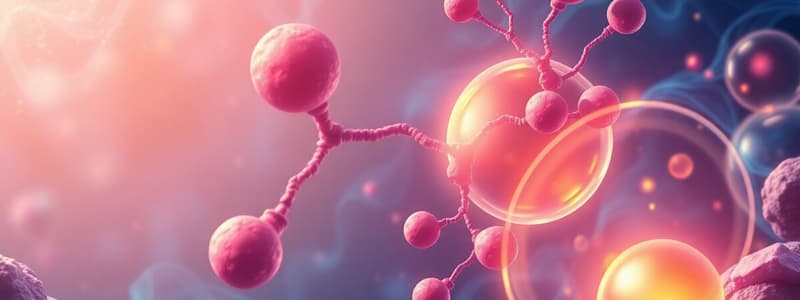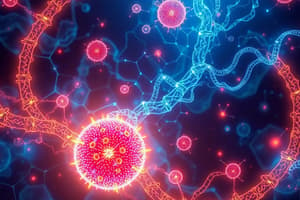Podcast
Questions and Answers
Which process breaks down proteins into amino acids?
Which process breaks down proteins into amino acids?
- Deamination
- Proteolysis (correct)
- Transamination
- Ubiquitination
The urea cycle primarily occurs in the:
The urea cycle primarily occurs in the:
- Liver (correct)
- Stomach
- Kidneys
- Small intestine
Which amino acid is the precursor for urea in the urea cycle?
Which amino acid is the precursor for urea in the urea cycle?
- Alanine
- Glutamate
- Ornithine
- Arginine (correct)
What is the enzyme responsible for removing the amino group during deamination?
What is the enzyme responsible for removing the amino group during deamination?
In transamination, an amino group is transferred to which molecule (ketoacid of glutamate)?
In transamination, an amino group is transferred to which molecule (ketoacid of glutamate)?
Which of the following is a ketogenic amino acid?
Which of the following is a ketogenic amino acid?
Which molecule directly donates ammonia for urea synthesis in the urea cycle?
Which molecule directly donates ammonia for urea synthesis in the urea cycle?
What is the end product of nitrogen metabolism in humans?
What is the end product of nitrogen metabolism in humans?
Essential amino acids are those that:
Essential amino acids are those that:
What is the fate of glucogenic amino acids?
What is the fate of glucogenic amino acids?
Which enzyme catalyzes the first step in the urea cycle?
Which enzyme catalyzes the first step in the urea cycle?
A defect in the enzyme argininosuccinate lyase causes:
A defect in the enzyme argininosuccinate lyase causes:
What is the main site of protein digestion?
What is the main site of protein digestion?
Which enzyme breaks down peptides into amino acids in the small intestine?
Which enzyme breaks down peptides into amino acids in the small intestine?
During starvation, protein metabolism contributes to:
During starvation, protein metabolism contributes to:
Protein turnover refers to the:
Protein turnover refers to the:
What is the main purpose of the urea cycle?
What is the main purpose of the urea cycle?
What happens to amino acids during starvation?
What happens to amino acids during starvation?
What is the intermediate product of aspartate transamination?
What is the intermediate product of aspartate transamination?
The conversion of glutamate to alpha-ketoglutarate generates:
The conversion of glutamate to alpha-ketoglutarate generates:
Flashcards
Proteolysis
Proteolysis
The process of breaking down proteins into amino acids.
Liver
Liver
The primary site where the urea cycle occurs, responsible for eliminating waste products from protein metabolism.
Arginine
Arginine
The amino acid that is the direct precursor for urea synthesis in the urea cycle.
Glutamate dehydrogenase
Glutamate dehydrogenase
Signup and view all the flashcards
Transamination
Transamination
Signup and view all the flashcards
Ketogenic amino acid
Ketogenic amino acid
Signup and view all the flashcards
Carbamoyl phosphate
Carbamoyl phosphate
Signup and view all the flashcards
Urea
Urea
Signup and view all the flashcards
Essential amino acids
Essential amino acids
Signup and view all the flashcards
Gluconeogenesis
Gluconeogenesis
Signup and view all the flashcards
Carbamoyl phosphate synthetase I
Carbamoyl phosphate synthetase I
Signup and view all the flashcards
Urea cycle disorder
Urea cycle disorder
Signup and view all the flashcards
Stomach
Stomach
Signup and view all the flashcards
Trypsin
Trypsin
Signup and view all the flashcards
Protein turnover
Protein turnover
Signup and view all the flashcards
Urea cycle
Urea cycle
Signup and view all the flashcards
Amino acids during starvation
Amino acids during starvation
Signup and view all the flashcards
Oxaloacetate
Oxaloacetate
Signup and view all the flashcards
Glutamate to alpha-ketoglutarate
Glutamate to alpha-ketoglutarate
Signup and view all the flashcards
Protein breakdown
Protein breakdown
Signup and view all the flashcards
Deamination
Deamination
Signup and view all the flashcards
Amino acids
Amino acids
Signup and view all the flashcards
Urea cycle
Urea cycle
Signup and view all the flashcards
Urea synthesis
Urea synthesis
Signup and view all the flashcards
Transaminases
Transaminases
Signup and view all the flashcards
Protein digestion
Protein digestion
Signup and view all the flashcards
Glucogenic amino acids
Glucogenic amino acids
Signup and view all the flashcards
Gluconeogenesis from amino acids
Gluconeogenesis from amino acids
Signup and view all the flashcards
Ornithine transcarbamoylase reaction
Ornithine transcarbamoylase reaction
Signup and view all the flashcards
Peptidases
Peptidases
Signup and view all the flashcards
Protein catabolism
Protein catabolism
Signup and view all the flashcards
Protein anabolism
Protein anabolism
Signup and view all the flashcards
Study Notes
Protein Metabolism MCQs
- Protein breakdown: Proteolysis breaks down proteins into amino acids.
- Urea cycle location: Primarily occurs in the liver.
- Urea precursor: Arginine is the precursor for urea in the urea cycle.
- Deamination enzyme: Glutamate dehydrogenase removes the amino group during deamination.
- Transamination recipient: Alpha-ketoglutarate receives the amino group during transamination, becoming glutamate.
- Ketogenic amino acid example: Lysine is an example of a ketogenic amino acid.
- Ammonia donor for urea: Carbamoyl phosphate donates ammonia for urea synthesis in the urea cycle.
- Nitrogen metabolism end product: Urea is the end product of nitrogen metabolism in humans.
- Essential amino acids: Essential amino acids must be obtained from the diet as the body cannot synthesize them.
- Glucogenic amino acid fate: Glucogenic amino acids are converted to glucose.
- Urea cycle first step enzyme: Carbamoyl phosphate synthetase I catalyzes the first step in the urea cycle.
- Argininosuccinate lyase defect: A defect in argininosuccinate lyase leads to urea cycle disorder.
- Main site of protein digestion: The stomach is the main site of protein digestion.
- Peptide breakdown enzyme: Trypsin breaks down peptides into amino acids in the small intestine.
- Starvation and protein metabolism: During starvation, proteins are used for gluconeogenesis.
- Protein turnover: Continuous breakdown and synthesis of proteins.
- Urea cycle purpose: To excrete nitrogen.
- Starvation and amino acids: Amino acids are used in gluconeogenesis during starvation.
- Aspartate transamination intermediate: Oxaloacetate is the intermediate product of aspartate transamination.
- Glutamate conversion product: Ammonia is generated when glutamate converts to alpha-ketoglutarate.
Studying That Suits You
Use AI to generate personalized quizzes and flashcards to suit your learning preferences.




